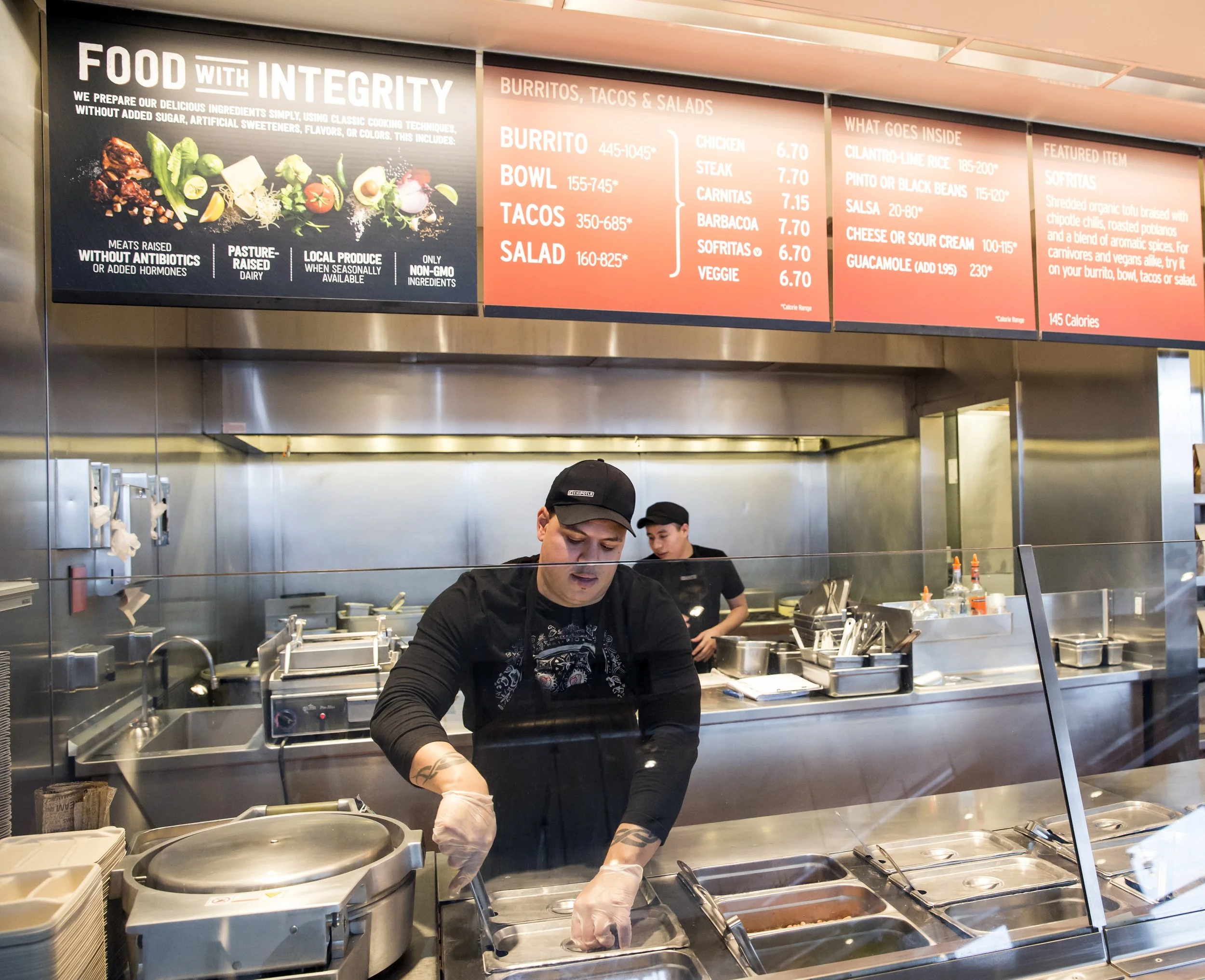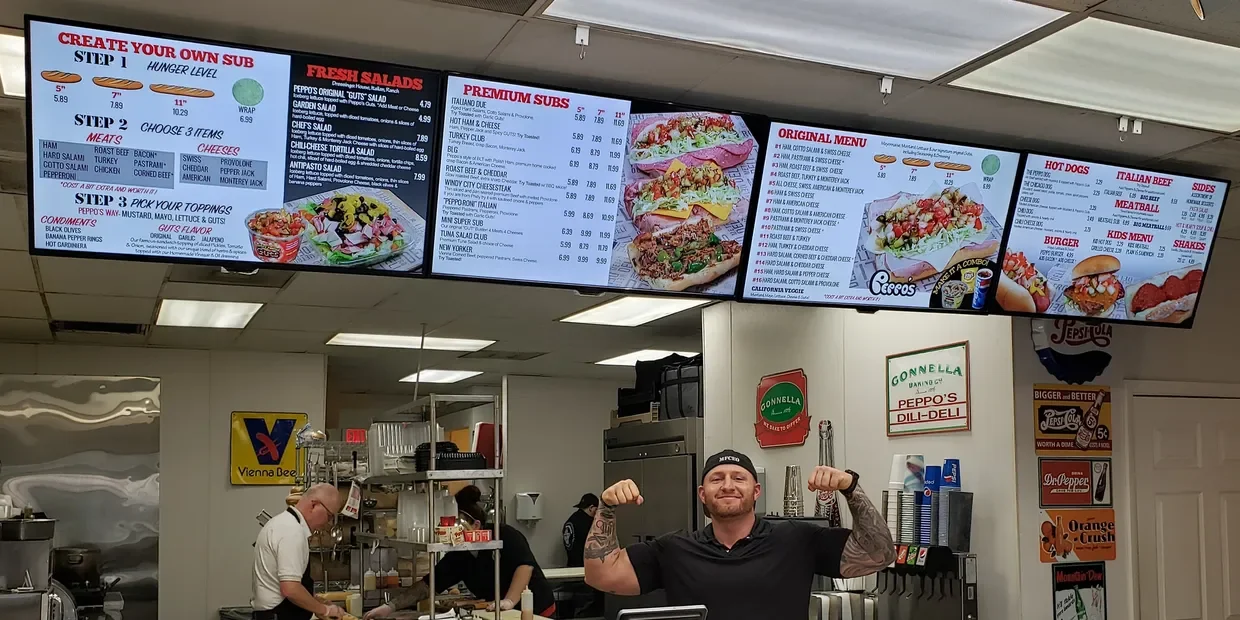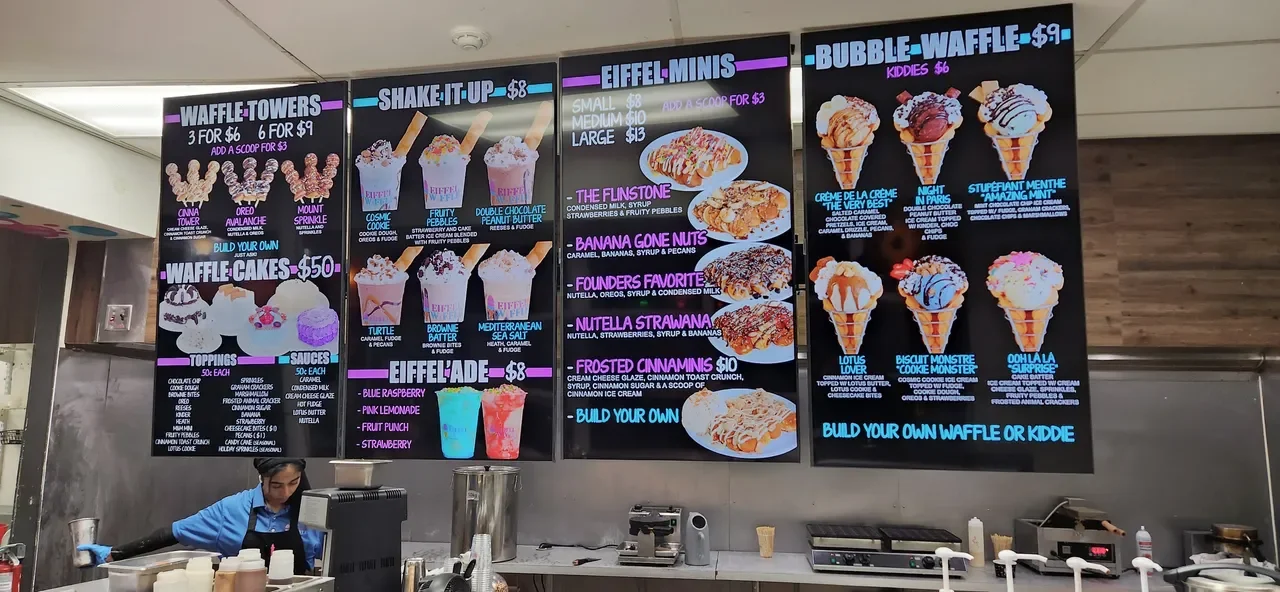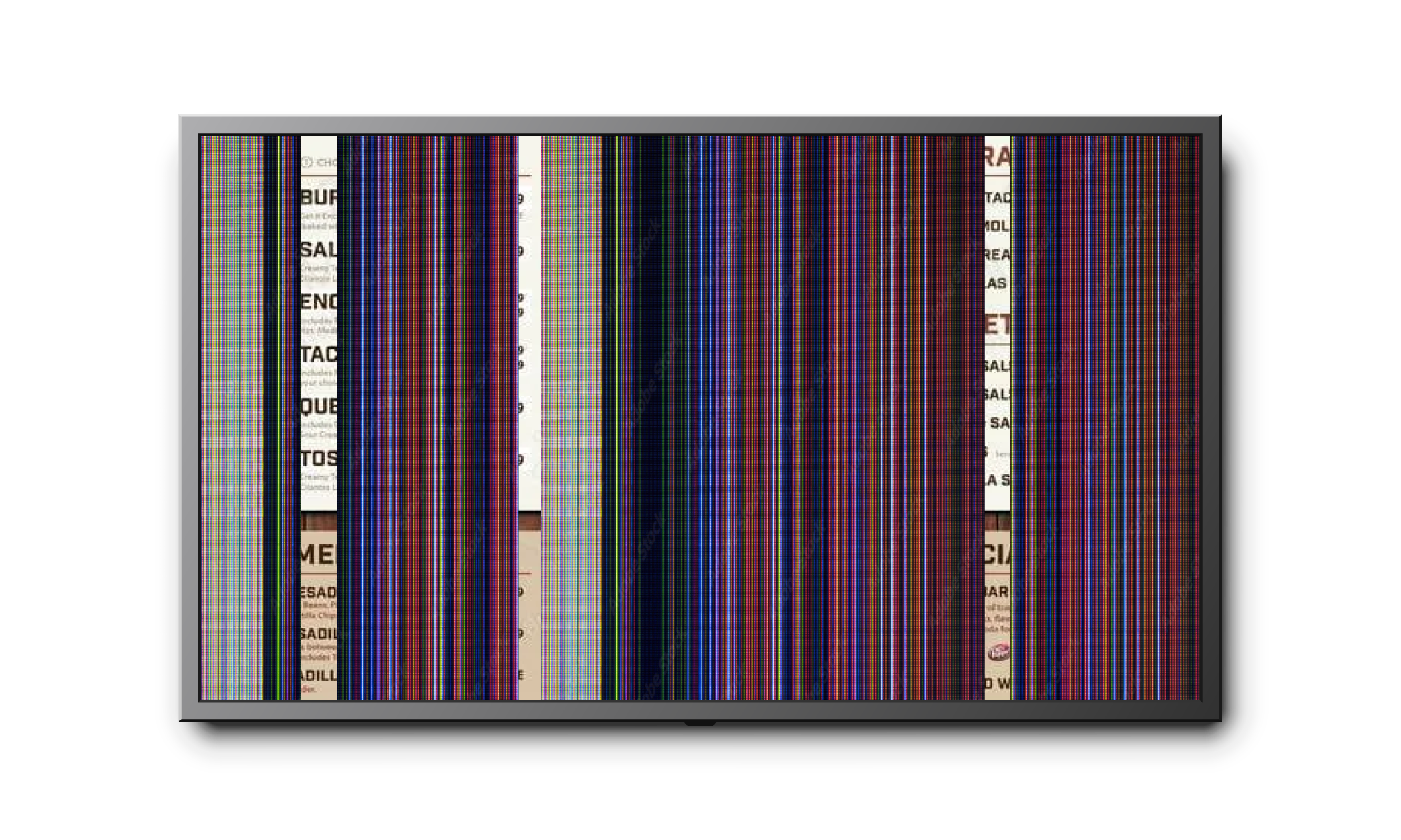TVs as Digital Menus in Restaurants: Are They Worth It?
With nearly 20 years of experience designing restaurant menus—both printed and digital—I’ve seen how core menu strategy, visual hierarchy, and operational constraints shape what works (and what doesn’t). Over the years, one of the biggest shifts has been toward using TVs as digital menu boards. They’re compelling from a design and operations perspective—but not without trade‑offs. In this post, I combine my hands-on lessons with real industry data and commentary.
Advantages of Using TVs as Digital Menu Boards
1. Instant Updates & Real-Time Flexibility
One of the strongest operational advantages is the ability to push menu changes across one or many screens instantly—no printing, no manual swaps.
“Digital signage ensures your menu content is always up to date by allowing instant updates across one or multiple locations.” AIScreen
“Digital signage also enables restaurant owners … to manage all digital menus … from a single platform and make modifications in real-time … This eliminates the need [to] painstakingly update static/plastic signs or redesign/reprint paper menus.” Digital Signage Today
I’ve seen how a last‑minute price change or item removal often leads to misprints, confusion, or rework. Digital gives you control and consistency.
2. Higher Engagement & Upsell Potential
TVs allow motion, animation, and rotating content, all of which draw attention more than static signs.
One commentary reports: “digital signage can net 400% more views than static ones.” Digital Signage Today
Another source states: “Unlike static displays, digital menu boards capture 400% more views and increase customer retention by up to 30%.” trudigital.com
This kind of visual pull can highlight high‑margin add-ons, combos, or promotions—essentially letting the signage do some of the upselling. I’ve used this strategy repeatedly in menu designs: place a rotating “suggested pair” panel or spotlight an add-on in the prime real estate of the screen.
3. Dayparting & Contextual Messaging
You can schedule different menus depending on time of day (breakfast, lunch, dinner), or rotate content dynamically.
As a Digital Signage Today article notes for drive-thru boards: “The ability to make real-time, strategic updates to your menus across hundreds of locations gives QSRs … a leg up over their competition.” Digital Signage Today
Also: “The ability to effectively day‑part … highlight menu items … at a particular time of day … without the store manager even having to think about it.” Digital Signage Today
From my experience, this is especially helpful in high‑volume or multi‑shift operations: you don’t need staff to manually swap board layouts for each meal period.
4. Branding, Storytelling & Cross‑Promotion
With digital screens, you can embed brand narratives, cross‑promotions, or partnerships in your menu flow.
One source explains: “digital signage creates opportunities for cross‑promotion and brand partnerships that weren’t possible with traditional menu boards.” Coffman Media
Another article on digital signage in restaurants states: “Restaurants can feature local businesses, community events, or complementary brands … in ways that add value to customers while creating additional revenue streams.” Coffman Media
In my menu designs, I often build in “soft zones” where local imagery or brand quotes can rotate without distracting from core menu content. It enhances the ambiance without diluting the ordering function.
5. Potential Long-Term Cost Savings
Digital signage reduces recurring costs like reprinting menus, making manual signage changes, and correcting misprinted pricing.
As one industry article puts it: “This ensures that customers always see accurate information … this … saving costs and improving operational efficiency.” AIScreen
Also: “Businesses can quickly update their digital menu boards to reflect changes in inventory, menu items or pricing … reducing the likelihood of order errors and customer dissatisfaction.” Digital Signage Today
When designing menus over long contracts or seasonal menus, I’ve often justified the digital investment by forecasting the number of print reworks those clients would avoid.
Disadvantages & Risks of Using TVs as Digital Menus
1. Significant Upfront & Ongoing Costs
To do it right, you’ll need commercial‑grade displays, sturdier mounts, media players, software, wiring, and more.
Many digital signage industry groups discuss benchmark and cost reports. For example, the Digital Signage Federation publishes finance and strategy insight for QSR digital signage. digitalsignagefederation.org
The “Finance Strategy Report for QSR Digital” from DSF provides insight into how vendors and operators view ROI, cost allocation, and economics of scaling signage across multiple units. digitalsignagefederation.org
In my own projects, the “hidden costs”—like control system licenses, cabling, mounting labor, and future refreshes—often exceed what many owners expect.
2. Technical Failures & Maintenance Overhead
TVs (especially consumer models) may not be built for 12–16 hours of continuous operation. Screen failures, software crashes, HDMI interruptions, power outages—all can disrupt your service.
Although I couldn’t find a direct modern NEC or Intel whitepaper in public search that matches your original references, many display solution providers (like NEC) emphasize the importance of using commercial-grade displays over consumer ones for durability, warranty, heat tolerance, and consistent brightness.
My own design practice always specifies commercial or “durable signage” screens (often with 3–5 year warranties) rather than off-the-shelf consumer TVs.
3. Readability & Visibility Issues
If not designed and placed well, digital menus can be hard to read—due to glare, viewing angle, font size, or color contrast.
In outdoor or bright interior areas, glare or ambient light can wash out the screen.
Fonts that look fine close up may be unreadable at 10–20 ft.
Designing menus for legibility across distances is a skill honed over decades: always do on‑site mockups and test readability from customer sightlines before finalizing layouts.
4. Distraction & Overdesign Risk
It’s tempting to go wild with animation, transitions, and motion—but too much can distract customers or slow their decision-making.
From my experience and client feedback: simplicity wins. Fewer transitions, more static frames with occasional motion, and strong visual hierarchy work best under rush periods.
5. Brand Fit & Customer Expectations
In some restaurant types—fine dining, boutique, heritage concepts—TV menus may feel cold, impersonal, or mismatched with the ambiance.
Even as a menu designer, I’ve advised clients in upscale settings to adopt hybrid solutions (e.g. printed menus supplemented with a digital board) so as not to displace the perceived value of a physical menu.
My Perspective
From a design and operational lens, TVs offer flexibility, branding power, and upsell potential—but only if executed thoughtfully. In my years of designing menus, I’ve learned:
Define your “core zones” on-screen (item names, pricing, visuals) versus rotating zones (promotions, brand messages).
Always storyboard your animations, and test them in simulation mode to ensure they don’t distract from menu reading.
Build in fail-safes: have a backup image or fallback layout in case connectivity or software fails.
Run pilot tests in one or two units before full rollout, to tune brightness, font size, transition speed, etc.
Plan for future refreshes: screens degrade, brands evolve, and your software must be modular enough to adapt.
Overall, TVs as digital menus make the most sense for fast casual, quick service, multi-unit operations, or restaurants with heavy menu churn. For boutique or fine dining, they can still be an enhancement—but rarely a full replacement.
Sources & Links
Driving Restaurant Ticket Averages with Digital Signage — “digital signage … manage all digital menus … from a single platform and make modifications in real-time … eliminates … static/plastic signs” Digital Signage Today
How Digital Menu Boards Improve Customer Experience — “instant updates … saving costs and improving operational efficiency” AIScreen
Digital Drive-Thru Menu Boards (Digital Signage Today) — “people find digital signage more appealing … digital signage can help to increase average purchase value by almost 30%” Digital Signage Today
Finance Strategy Report for QSR Digital (Digital Signage Federation) — provides insight into financial and cost benchmarks for QSR digital signage implementation and scaling digitalsignagefederation.org
9 Strategies for Boosting Revenue with Digital Menu Boards — “Businesses can quickly update their digital menu boards … reducing the likelihood of order errors and customer dissatisfaction” Digital Signage Today
How Digital Signage Boosts Restaurant Sales (TruDigital) — “digital menu boards capture 400% more views and increase customer retention by up to 30%” trudigital.com
Enhancing Customer Engagement: How Restaurant Digital Signage Transforms Interactions — on reducing perceived wait times, influencing purchases via digital signage displaynow.io
BrightSign blog: Digital Signage for Restaurants — “more than 80% of restaurant business owners reported increased orders since adopting digital signage … strategic timing … influencing purchasing decisions” BrightSign®





